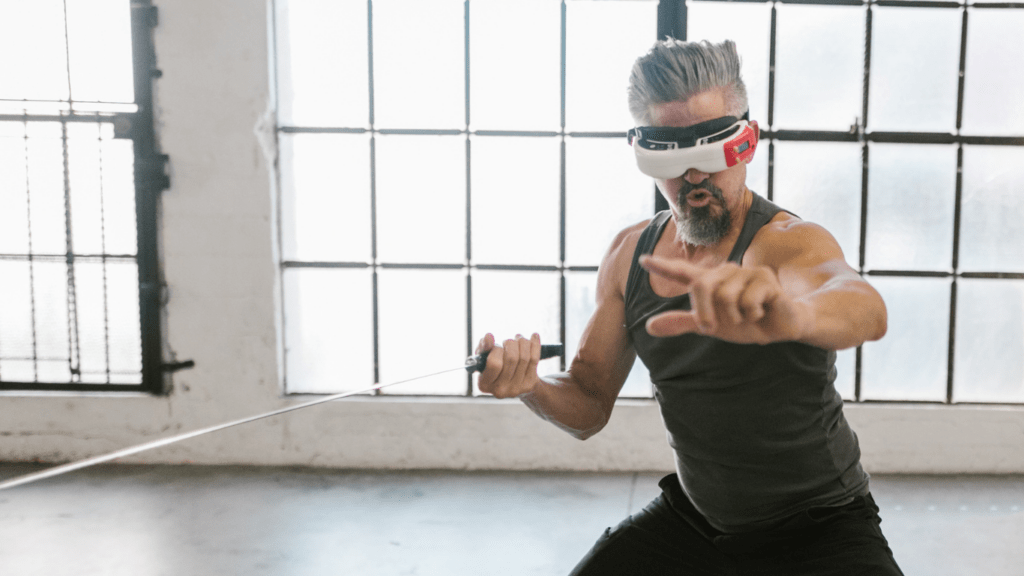The Rise of Innovative Fitness Programs
Innovative fitness programs emerged to address the monotony of traditional workouts. High-tech solutions like virtual reality (VR) workouts revolutionized exercise, providing immersive experiences that keep users engaged. For instance, platforms like Black Box VR offer competitive gaming-style fitness challenges, blending cardio and strength training in a virtual environment.
Hybrid classes also grew in popularity. These programs mix different exercise styles, such as yoga with strength training. Examples include CorePower Yoga’s Yoga Sculpt, which blends yoga, free weights, and cardio for a comprehensive workout.
Wearable technology further contributed to the innovation. Devices like Fitbit and Apple Watch not only track activity levels but also provide personalized training programs. They offer real-time data, allowing users to adjust their workouts for maximum effectiveness.
Group fitness evolved with innovative program formats. Fitness boot camps, combining high-intensity interval training (HIIT) with team-based exercise, became widely popular. Camp Gladiator, for example, offers outdoor group fitness classes that focus on strength, endurance, and conditioning.
Personalized training apps made workouts more accessible. Apps like Peloton and Mirror provide on-demand classes tailored to individual preferences and fitness levels. They offer a variety of classes, from cycling to strength training, with professional instructors guiding users through each session.
These developments indicate a significant shift in how people approach fitness, emphasizing variety, engagement, and personalization.
Virtual Reality Workouts

Virtual reality workouts offer a unique, immersive fitness experience, combining gaming elements with physical exercise. By engaging the mind and body simultaneously, they provide an innovative alternative to traditional fitness routines.
Benefits Of VR Fitness
VR fitness provides several benefits that enhance the workout experience:
- Engagement: VR workouts keep participants fully engaged, unlike traditional methods that often result in boredom. Immersive environments make the exercise feel less like a chore and more like a game.
- Motivation: Gamified elements in VR workouts offer rewards and achievements that motivate users to push themselves. Completing levels or earning points provides a sense of accomplishment.
- Access: Users can perform VR workouts from the comfort of their own homes. This eliminates the need to commute to the gym, making fitness more accessible.
- Customization: VR workouts can be tailored to individual fitness levels. Programs adapt based on user performance, ensuring workouts are challenging but not overwhelming.
- Low Impact: Many VR fitness programs focus on low-impact activities. This reduces stress on joints, making them suitable for people of all ages and fitness levels.
Popular VR Fitness Apps
A variety of VR fitness apps are available that provide diverse workout experiences:
- Supernatural: This app offers guided workouts in stunning virtual landscapes. Coaches lead sessions, which include cardio, stretching, and meditation, all synchronized with music.
- FitXR: FitXR includes boxing, dance, and HIIT workouts. Multiplayer mode lets users compete with friends, adding a social element to fitness.
- Beat Saber: Players slash blocks to the rhythm of music in this immersive game. It combines fun with physical intensity, providing a full-body workout.
- BoxVR: BoxVR focuses on boxing-inspired workouts designed by fitness instructors. Sessions range from short bursts to longer routines, catering to different user preferences.
- Thrill of the Fight: This app offers a realistic boxing simulation. Users train and fight in virtual arenas, improving strength and stamina.
These VR fitness apps offer diverse, engaging workouts that cater to various fitness preferences, making it easier than ever to enjoy physical exercise.
HIIT with a Twist
High-Intensity Interval Training (HIIT) offers a dynamic approach to fitness, but adding a twist makes it even more exciting. By integrating modern technology and unique variations, we can elevate the HIIT experience.
Incorporating Technology in HIIT
Incorporating technology into HIIT workouts enhances engagement and effectiveness. Apps like Freeletics and Keelo provide customized HIIT routines based on individual fitness levels and goals.
Wearable tech, such as heart rate monitors and fitness trackers, offers real-time data that helps optimize performance by ensuring workouts are performed at the right intensity.
For example:
- Wearable tech: Devices in this category ensure accurate tracking of heart rate and calories burned.
- Fitness apps: Platforms like Freeletics provide tailored HIIT workouts with instructional videos for proper form.
- Virtual trainers: Services like Peloton and Mirror offer live feedback and real-time adjustments during workouts, further personalizing the experience.
Unique HIIT Variations
Unique HIIT variations keep workouts fresh and challenging, preventing plateaus and boredom. Combining traditional HIIT with other training styles, such as boxing or yoga, adds diversity.
Examples of unique HIIT variations include:
- Boxing HIIT: Classes like those offered by Rumble incorporate boxing drills with high-intensity intervals, enhancing cardiovascular fitness and strength.
- Yoga HIIT: Hybrid classes such as CorePower Yoga’s Yoga Sculpt blend yoga poses with HIIT, improving flexibility, strength, and endurance.
- Dance HIIT: Dance-based HIIT sessions, like Zumba Strong, mix rhythmic movements with intense intervals for a fun, full-body workout.
Integrating these variations not only spices up routine but also targets different muscle groups, ensuring balanced fitness progress.
Mind-Body Fusion Programs
Combining mental and physical wellness, mind-body fusion programs create a comprehensive approach to fitness. These programs integrate physical exercise with mindfulness techniques, enhancing overall well-being.
Yoga and Pilates Hybrids
Yoga and Pilates hybrids blend the flexibility focus of yoga with the core strength emphasis of Pilates. By combining these practices, participants develop both muscular endurance and mental clarity.
PiYo, for instance, mixes Pilates and yoga into a high-intensity, low-impact workout. PiYo sessions improve flexibility, stability, and muscle tone while reducing stress.
Meditation and Fitness Blends
Meditation and fitness blends integrate mindfulness practices with physical activity. These programs enhance mental focus while improving physical fitness.
FitMindful workouts incorporate guided breathing exercises, meditation intervals, and traditional cardio exercises. Adding meditation to fitness routines helps lower stress levels, improve mental clarity, and boost overall health.
Social Fitness Apps
Social fitness apps offer innovative ways to stay connected and motivated. They integrate social interaction with physical activity, enhancing engagement and accountability.
Gamification of Workouts
Gamification turns workouts into engaging experiences. Apps like Zwift and Zombies, Run! encourage users to reach fitness goals through fun, game-like scenarios.
Zwift creates virtual cycling and running environments where users compete in real-time races. Zombies, Run! immerses users in a post-apocalyptic story, motivating them to run faster to “escape” zombies. These game elements make exercise feel less like a chore and more like an adventure.
Community Challenges and Competitions
Community challenges and competitions foster a sense of camaraderie. Strava and MyFitnessPal enable users to join groups, set goals, and compete in challenges.
Strava offers features like leaderboards, segments, and monthly challenges to keep users engaged. MyFitnessPal incorporates social features where users share progress, offer support, and participate in community goals. These elements boost motivation by tapping into friendly competition and collective effort, making fitness a shared experience rather than an isolated task.
Personalized Training with AI
AI technology is revolutionizing how individuals approach fitness. These advancements allow highly customized workout experiences tailored to personal goals and performance metrics.
AI-Powered Fitness Apps
AI-powered fitness apps analyze user data to provide tailored exercise recommendations. Examples include Freeletics and Aaptiv Coach. These apps track progress using algorithms, delivering workout plans that adapt based on user performance and physical condition. By leveraging AI, users can achieve optimal results faster.
Adaptive Workout Plans
Adaptive workout plans adjust routines in real-time. Based on immediate feedback, these plans offer dynamic modifications to exercises. For instance, the app Fitbod adapts weightlifting routines based on user performance, ensuring that workouts remain challenging yet attainable. This personalized approach helps maintain motivation and efficiency.
 Laurae Parhamim is the founder of Top Wellness Activity Hub, a comprehensive platform dedicated to promoting holistic health and wellness. With a passion for well-being and a deep understanding of the latest trends in health practices, Laurae has crafted a space that serves as a go-to resource for individuals seeking to enhance their physical, mental, and emotional health. Under Laurae's leadership, the platform offers a wide array of content, from nutritious eating tips to the intricacies of yoga, Pilates, and meditation. The goal is to provide valuable insights and practical advice that empower individuals to lead healthier, more balanced lives.
Laurae's dedication to wellness stems from a belief in the transformative power of healthy habits and mindful practices. Recognizing the importance of accessible, reliable information, Laurae has also integrated gear reviews and updates on wellness trends to ensure users are well-equipped on their journey to well-being. This comprehensive approach reflects Laurae's commitment to creating a platform that caters to both beginners and seasoned wellness enthusiasts. As the visionary behind Top Wellness Activity Hub, Laurae continues to innovate, inspire, and guide others towards achieving their wellness goals.
Laurae Parhamim is the founder of Top Wellness Activity Hub, a comprehensive platform dedicated to promoting holistic health and wellness. With a passion for well-being and a deep understanding of the latest trends in health practices, Laurae has crafted a space that serves as a go-to resource for individuals seeking to enhance their physical, mental, and emotional health. Under Laurae's leadership, the platform offers a wide array of content, from nutritious eating tips to the intricacies of yoga, Pilates, and meditation. The goal is to provide valuable insights and practical advice that empower individuals to lead healthier, more balanced lives.
Laurae's dedication to wellness stems from a belief in the transformative power of healthy habits and mindful practices. Recognizing the importance of accessible, reliable information, Laurae has also integrated gear reviews and updates on wellness trends to ensure users are well-equipped on their journey to well-being. This comprehensive approach reflects Laurae's commitment to creating a platform that caters to both beginners and seasoned wellness enthusiasts. As the visionary behind Top Wellness Activity Hub, Laurae continues to innovate, inspire, and guide others towards achieving their wellness goals.